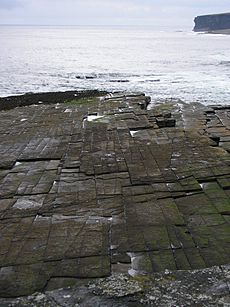Joint (geology) facts for kids

In geology, a joint is a fracture dividing rock into two sections that moved away from each other. A joint does not involve shear displacement, and forms when tensile stress breaches its threshold. In other kinds of fracturing, like in a fault, the rock is parted by a visible crack that forms a gap in the rock.
Joints push out in various directions, usually vertically. They can have smooth, clean surfaces, or they can be scarred from sliding against another joint. Joints usually occur as sets, with each set made up of joints that are parallel to each other.
Joints become more and more obvious when the rock is weathered (eroded by the elements). When water gets into the joints, this can lead to the formation of big caves and underground rivers.
Images for kids
-
Horizontal joints in the sedimentary rocks of the foreground and a more varied set of joints in the granitic rocks in the background. Image from the Kazakh Uplands in Balkhash District, Kazakhstan.
-
Joints in the Almo Pluton, City of Rocks National Reserve, Idaho.
-
Columnar jointed basalt in Turkey
-
Columnar jointing in basalt, Marte Vallis, Mars
-
Recent tectonic joint intersects older exfoliation joints in granite gneiss, Lizard Rock, Parra Wirra, South Australia.
-
Joint spacing in mechanically stronger limestone beds shows increase with bed thickness, Lilstock Bay, Somerset
See also
 In Spanish: Diaclasa para niños
In Spanish: Diaclasa para niños










